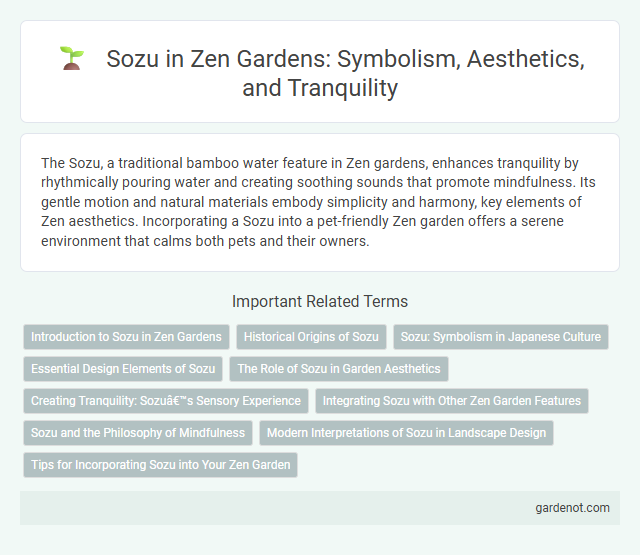The Sozu, a traditional bamboo water feature in Zen gardens, enhances tranquility by rhythmically pouring water and creating soothing sounds that promote mindfulness. Its gentle motion and natural materials embody simplicity and harmony, key elements of Zen aesthetics. Incorporating a Sozu into a pet-friendly Zen garden offers a serene environment that calms both pets and their owners.
Introduction to Sozu in Zen Gardens
Sozu, a traditional Japanese water feature, is an essential element in Zen gardens that exemplifies the harmony between nature and sound. Constructed from bamboo tubes pivoted to create rhythmic water flow and audible clicks, sozu serves both as an aesthetic focal point and a natural deterrent for animals. This serene mechanism enhances mindfulness and tranquility, embodying the Zen principles of simplicity and purposeful design.
Historical Origins of Sozu
The Sozu, a traditional bamboo water fountain used in Zen gardens, traces its origins to 16th-century Japan during the Azuchi-Momoyama period. Designed to enhance tranquility through rhythmic sounds, the Sozu historically functioned to scare away animals such as deer and birds from garden vegetation. Its integration in Zen gardens reflects the Japanese cultural emphasis on harmony between nature and meditative space.
Sozu: Symbolism in Japanese Culture
Sozu, also known as shishi-odoshi, is a traditional bamboo water feature symbolizing harmony and the impermanence of life in Japanese culture. Its rhythmic clacking sound represents the natural cycle of renewal and the balance between tranquility and movement in Zen gardens. This water mechanism embodies the interplay between nature and human presence, fostering mindfulness and reflection.
Essential Design Elements of Sozu
The Sozu, a traditional Japanese garden water feature, embodies essential design elements such as bamboo construction, rhythmic movement, and natural sound. Its pivoting bamboo tube fills with water and tips to create a soothing knocking noise that harmonizes with the Zen garden's tranquil atmosphere. Strategically placed among rocks and moss, the Sozu integrates seamlessly into the landscape, enhancing meditation and mindfulness.
The Role of Sozu in Garden Aesthetics
The sozu, a traditional bamboo water fountain, enhances garden aesthetics by introducing dynamic sound and movement that complements the tranquil environment of a Zen garden. Its rhythmic clacking and flowing water create a sensory experience symbolizing the harmony between nature and human presence. This intentional integration of auditory elements adds depth to the minimalist design, emphasizing the principles of balance and mindfulness in Japanese garden art.
Creating Tranquility: Sozu’s Sensory Experience
The sozu, a traditional bamboo water fountain, creates tranquility through its rhythmic clacking sound, evoking a calming sensory experience in Zen gardens. Its intermittent water flow and natural materials engage sight, sound, and touch, enhancing mindfulness and relaxation. This harmonious interaction between water and bamboo embodies wabi-sabi aesthetics, fostering a meditative atmosphere.
Integrating Sozu with Other Zen Garden Features
Integrating sozu into Zen gardens enhances the harmony between natural elements and spiritual ambiance by combining the rhythmic bamboo water fountain with rocks, moss, and carefully raked gravel patterns. Positioning the sozu near stone lanterns or koi ponds accentuates sound and visual tranquility, creating a multisensory experience that deepens mindfulness. The interplay between water motion and auditory cues from the sozu complements the minimalist design principles fundamental to traditional Zen garden aesthetics.
Sozu and the Philosophy of Mindfulness
Sozu, a traditional bamboo water fountain in Zen gardens, embodies the philosophy of mindfulness by creating rhythmic sounds that encourage present-moment awareness. This gentle, continuous motion symbolizes the flow of life and helps practitioners cultivate calmness and focus. The interplay of water and bamboo in the sozu enhances sensory experience, reinforcing mental clarity and meditative presence.
Modern Interpretations of Sozu in Landscape Design
Modern interpretations of the Sozu in landscape design embrace sustainable materials and minimalist aesthetics to enhance tranquility and natural rhythm within Zen gardens. Designers integrate solar-powered mechanisms or recycled bamboo, maintaining the iconic water percussion sound while reducing environmental impact. These contemporary adaptations preserve the Sozu's symbolic function as a mindfulness trigger and deterrent for wildlife without compromising traditional visual harmony.
Tips for Incorporating Sozu into Your Zen Garden
Integrate a Sozu into your Zen garden by placing it near natural water sources to amplify the soothing bamboo water sounds essential for tranquility. Use native plants and smooth stones around the Sozu to enhance the natural aesthetic and maintain harmony within the garden's minimalist design. Ensure the bamboo water spout is properly balanced to achieve rhythmic water flow, which promotes meditation and relaxation.
Sōzu Infographic

 gardenot.com
gardenot.com